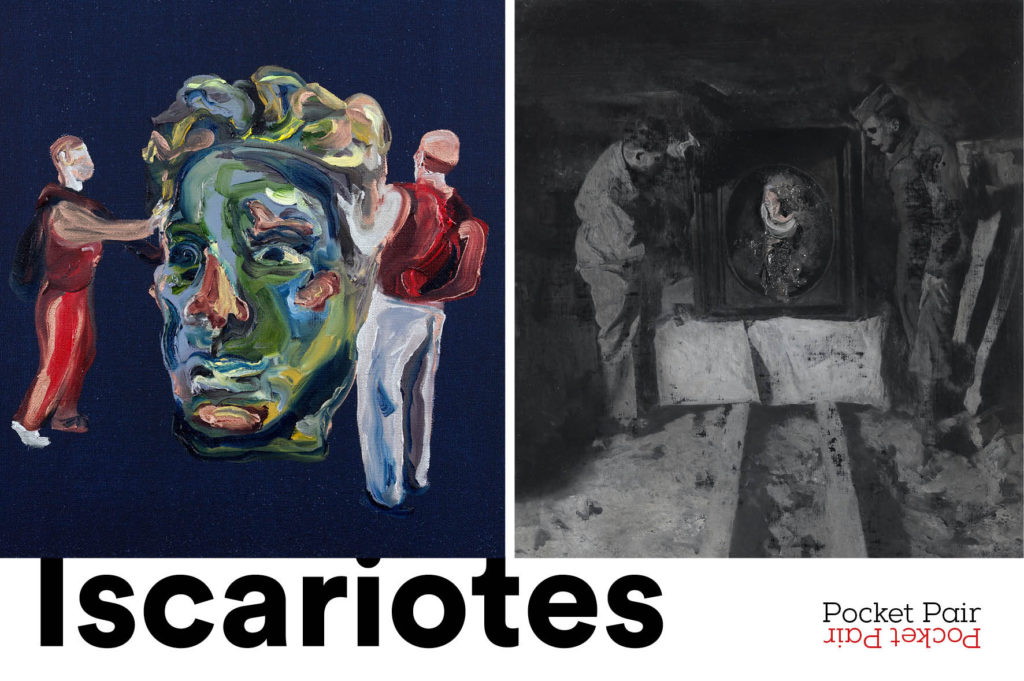ISCARIOTES
Matteo Fato and Nicola Samorì
Curated by Alberto Zanchetta
Casa Testori
8 April – 20 May 2018

MANUS TRADENTIS
Alberto Zanchetta
The apostle Judas embodies that apostasy and that apologia that belongs to both Matteo Fato and Nicola Samorì. And, just like Judas, even the Fine Arts can be brought to suicide and to their own redemption. Under the aegis of a sacrifice that won’t go unpunished, the exhibition is marked by the word Iscariotes, a proper name added to the triangulation that involves the artists and the curator.
As a curator I am possessed by the Demon of Analogy, which is the reason why – in an attempt to bypass the biographical notes – I usually define myself as an “analogous pathologist”. But, as counselled by Goethe: «if we follow the analogy too far, all things confound themselves in identity». Well, what torments me is not the equivalences but rather the offshoots that are created between one work and another, and between one author and another. Aware of the fact that one work should never be compared to another, in as much as each one has its own specific and special character, I force myself to understand the backbone of the division between identity and identical, opposing concepts that share the same etymology. My echo is that of the demon possessed, which imposes itself, obsessing, persecuting and pursuing the objectives of an ipseity of artistic meta-languages.
I have entertained a long-term, constant dialogue with the two artists presented here, peppered with reciprocal stimuli, intuitions, coincidences and challenges.
Fato and Samorì had known each other for many years but had never been able to bring to fruition an attractio electiva duplex that they both craved; I therefore wanted to intercept this craving, which I too had repeatedly nurtured, bringing their “missed appointment” into actuality. The consanguinity of these authors is more than a gamble, it is a discovery of ideas and operational finesse, of artistic crises and betrayals that become an act of affirmation and responsibility. I consider this exhibition an ineluctable “touchstone” that only a few years ago would have been dismissed as a “stumbling stone”, if not for the fact that in the meantime the three of us have become – wanting to paraphrase Nicola – “venerable abjects” (venerabili abietti). The exhibition has therefore been conceived as a recto/verso of Painting, succeeding increasingly in exceeding the all-round nature of Sculpture, as well as revealing its highs and the lows.
The Mephistophelean pride of non serviam (betraying tradition) transforms the sin of vanity into a virtue; instead of reassuring the gaze, the two artists try to agitate it with defeats and triumphs, capitulation and resistance, intermittence and persistence. Paintings, sculptures, drawings, collages and engravings establish a [s]elective affinity, where analogies and chance reveal a contiguity of intentions that nevertheless bifurcate, with Samorì sloping into darkness and turmoil and Fato cresting a bright and numinous ridge. The contra[di]ctions that are manifest when the gaze is shifted from one artist to the other demonstrate an iconoclasm that no longer consists of destroying images, but increasingly of producing new ones that – in an infinite spiral – confine the previous ones to oblivion. If these works embody a “sin”, the sin certainly comes from a place of remorse and is, on the contrary, trying to bring out that which has been removed; it is in this sense that the tributes by both artists to Giovanni Testori must be read, interventions into books and paintings he loves that are completely transfigured/disfigured.
Iscariotes opens Pocket Pair, a cycle of exhibitions coordinated by Marta Cereda and launched by Casa Testori in 2018. The title of the cycle takes up an expression from poker that indicates the situation in which a player has two cards of equal value, and must bet on them. In the same way, the curators are betting on emerging talents, two artists of equal value, to give life to a high quality two-person exhibition, set up on the ground floor of Casa Testori where they are free to meet, even within the individual rooms, to visit each other, to dialogue closely.
«I took up the challenge and decided to play two aces», says Alberto Zanchetta, the director of MAC in Lissone, who decided to invite two artists with an important curriculum and connected by a common reflection on painting and sculpture.
